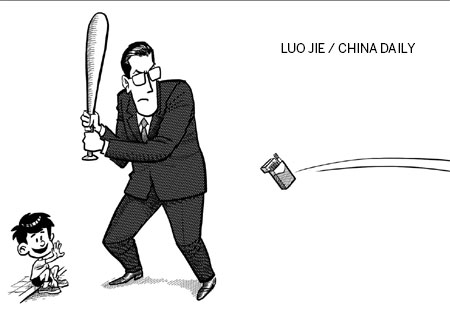Reduce kids' exposure to smoking
Updated: 2012-05-31 08:08
By Wang Yiqing (China Daily)
|
||||||||

My father began smoking when he was a freshman in college. His friend passed him his first cigarette. He has now been smoking for more than 30 years.
It's a classic example of how a young person is introduced to cigarettes, except that nowadays smokers develop their habit at an even younger age. Effective tobacco control targeting adolescents has become increasingly urgent. The Chinese Association on Tobacco Control surveyed 38,839 junior and high school students in 11 provinces in 2011 and found that 22.5 percent of the students surveyed had tried smoking and 15.8 percent of them smoke regularly. Both figures were higher than the results of a survey in 2005.
The most effective way to reduce the number of smokers in the country is to persuade young people not to start smoking in the first place. International practice shows that increasing the price of cigarettes by imposing taxes is an effective way to reduce the number of young smokers, as adolescents have limited money to spend on cigarettes.
A Hong Kong University survey of more than 50,000 middle school students in 85 schools in the special administrative region found that the smoking rate among students dropped from 6.9 percent in 2009 to 3.4 percent in 2010 after the government increased the tax on tobacco.
China's tobacco tax accounts for less than 50 percent of the retail price of cigarettes; significantly lower than the 67-80 percent recommended by the World Health Organization. Increasing tobacco tax is both feasible and necessary in China as Minister of Health Chen Zhu recently acknowledged.
But we can't just count on "price-controlling" adolescents' behavior. We must persuade them to voluntarily refuse cigarettes. However, anti-smoking education and campaigns have little effect.
For example, the survey by the Chinese Association on Tobacco Control found that 92.5 percent of students know smoking will be bad for their health, but only 7.2 percent will refuse a cigarette offered by their peers. And for many adolescent smokers cigarettes are a symbol of their independence. In fact, teenage rebellion makes rules and prohibitions against smoking a trigger for some to start smoking. After all, it is common for teenagers to rebel against teachers and parents, and do whatever they are forbidden from doing.
The social environment also plays an important role in attracting adolescents to smoking. Generally speaking, Chinese society has a high tolerance for smoking. Cigarettes are a part of the Chinese "gift" culture and young kids are used to seeing their elders, especially male family members, smoking at home. This gives them the impression that there's nothing wrong with smoking. Kids want to feel mature by imitating adult behavior, and many see smoking as a symbol of being an adult.
This is reinforced by images of smoking in movies and television programs, where there are countless scenes of grown-ups smoking. The Chinese Center for Disease Control and Prevention found that more than half of the movies shown in the Chinese mainland in 2009 had smoking scenes.
Smoking on screen is always related to images of independence, maturity, attractiveness and success, which is exactly what kids pursue. The Chinese Association on Tobacco Control found that adolescents will be 16 times more likely to smoke if their idols smoke.
We may urge the government to take responsibility for an anti-smoking campaign targeting adolescents, but society and grown-ups influence young people's attitudes toward smoking. Therefore reducing adolescents' exposure to smoking in daily life and introducing strict regulations to restrict scenes of smoking in films and TV programs will be more effective than empty slogans and warnings on cigarette packs.
The author is a writer with China Daily
wangyiqing@chinadaily.com.cn

 Relief reaches isolated village
Relief reaches isolated village
 Rainfall poses new threats to quake-hit region
Rainfall poses new threats to quake-hit region
 Funerals begin for Boston bombing victims
Funerals begin for Boston bombing victims
 Quake takeaway from China's Air Force
Quake takeaway from China's Air Force
 Obama celebrates young inventors at science fair
Obama celebrates young inventors at science fair
 Earth Day marked around the world
Earth Day marked around the world
 Volunteer team helping students find sense of normalcy
Volunteer team helping students find sense of normalcy
 Ethnic groups quick to join rescue efforts
Ethnic groups quick to join rescue efforts
Most Viewed
Editor's Picks

|

|

|

|

|

|
Today's Top News
Health new priority for quake zone
Xi meets US top military officer
Japan's boats driven out of Diaoyu
China mulls online shopping legislation
Bird flu death toll rises to 22
Putin appoints new ambassador to China
Japanese ships blocked from Diaoyu Islands
Inspired by Guan, more Chinese pick up golf
US Weekly

|

|






